Shopping Tourism in Dubai: A Case Study
Prepare a report proposing the research methodology and discussing findings of a new or existing tourism theme/s in consideration of emerging tourism issues or trends.
48 Pages8808 Words420 Views
Added on 2023-06-09
About This Document
This paper explores the emerging trend of shopping tourism in Dubai, identifying tourist profiles and key points that draw them to Dubai. The study aims to identify scopes of improvement in the current setup of Dubai in light of the identified trends.
Shopping Tourism in Dubai: A Case Study
Prepare a report proposing the research methodology and discussing findings of a new or existing tourism theme/s in consideration of emerging tourism issues or trends.
Added on 2023-06-09
ShareRelated Documents
Running head: SHOPPING TOURISM IN DUBAI: A CASE STUDY
SHOPPING TOURISM IN DUBAI: A CASE STUDY
Name of Student
Name of University
Author Note
SHOPPING TOURISM IN DUBAI: A CASE STUDY
Name of Student
Name of University
Author Note
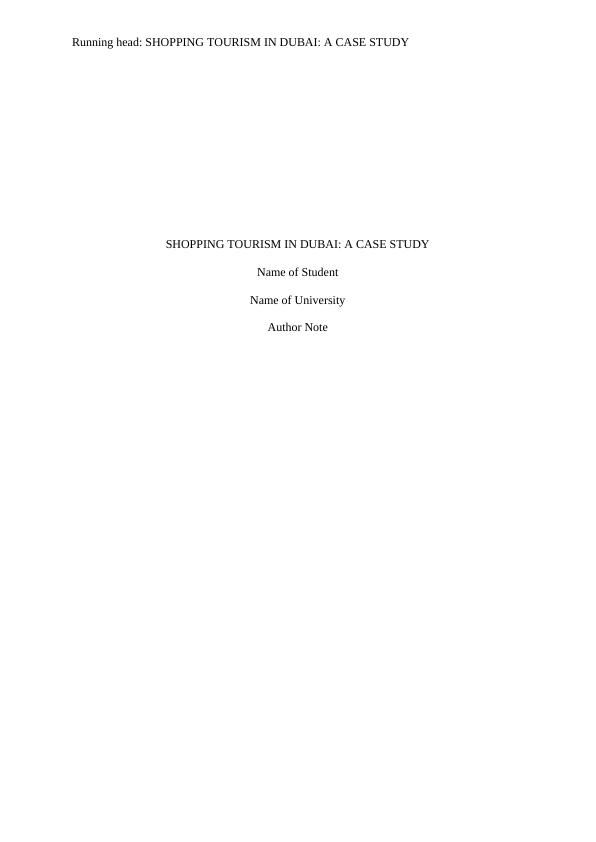
Table of Contents
1. Background to the project:..................................................................................................3
2.Concepts and relevant theories................................................................................................5
3. Proposed research methodology and analysis:.......................................................................8
3.1. Research Objectives:.......................................................................................................8
3.2. Research Questions:........................................................................................................8
3.3. Methodology:..................................................................................................................8
3.4. Research Hypothesis.......................................................................................................9
4. Results and discussions:.......................................................................................................10
5. Conclusions and Recommendations:...................................................................................39
Reference..................................................................................................................................41
Appendix..................................................................................................................................44
1. Background to the project:..................................................................................................3
2.Concepts and relevant theories................................................................................................5
3. Proposed research methodology and analysis:.......................................................................8
3.1. Research Objectives:.......................................................................................................8
3.2. Research Questions:........................................................................................................8
3.3. Methodology:..................................................................................................................8
3.4. Research Hypothesis.......................................................................................................9
4. Results and discussions:.......................................................................................................10
5. Conclusions and Recommendations:...................................................................................39
Reference..................................................................................................................................41
Appendix..................................................................................................................................44

1. Background to the project:
Cities are the economic hubs of a region, which drives business. They attract people
from around the world for various purposes, both business and leisure. Therefore aside from
being business destinations they have developed various recreational attractions to engage
locals and tourists alike. These urban spaces are often found to fashion the same model that
are found across various modernized cities of the world forming an extension of the “urban
lifestyle”. It has been observe that many tourists today prefer to partake in the distinctiveThe
UNWTO describes urban tourism to be an activity related to tourism activities associated
with urban space. The industry that is related to such are non-agricultural economy sectors
such as retail, manufacturing, transport, trade, administration and services (UNWTO 2018).
The experience that is urban tourism involves elements of cultural, technological, social, and
architectural as well as to some extent natural disposition of the urban, modernized regions of
the country of visit in terms of product and service preferences.
Shopping tourism is one of the major categories of urban tourism. Destination
shopping have come to form the strength of the tourism campaigns of many countries.
Singapore, Thailand, Malaysia, Dubai are some of the notable examples. Shopping festivals,
year round markets offering diverse as well as unique experience and products are one of the
key features promoted by many. Examples would be that of the Great Singapore Sale, Dubai
Shopping Festival (DSF), Malaysia Year End Sale, Magnificent Mile Shopping Festival and
Amazing Thailand Grand Sale (Peter and Anandkumar 2016).
The past sixty years have experienced fast growth and diversification of the tourism
industry as waves of globalization swept the world. The scope of tourism expanded from the
Cities are the economic hubs of a region, which drives business. They attract people
from around the world for various purposes, both business and leisure. Therefore aside from
being business destinations they have developed various recreational attractions to engage
locals and tourists alike. These urban spaces are often found to fashion the same model that
are found across various modernized cities of the world forming an extension of the “urban
lifestyle”. It has been observe that many tourists today prefer to partake in the distinctiveThe
UNWTO describes urban tourism to be an activity related to tourism activities associated
with urban space. The industry that is related to such are non-agricultural economy sectors
such as retail, manufacturing, transport, trade, administration and services (UNWTO 2018).
The experience that is urban tourism involves elements of cultural, technological, social, and
architectural as well as to some extent natural disposition of the urban, modernized regions of
the country of visit in terms of product and service preferences.
Shopping tourism is one of the major categories of urban tourism. Destination
shopping have come to form the strength of the tourism campaigns of many countries.
Singapore, Thailand, Malaysia, Dubai are some of the notable examples. Shopping festivals,
year round markets offering diverse as well as unique experience and products are one of the
key features promoted by many. Examples would be that of the Great Singapore Sale, Dubai
Shopping Festival (DSF), Malaysia Year End Sale, Magnificent Mile Shopping Festival and
Amazing Thailand Grand Sale (Peter and Anandkumar 2016).
The past sixty years have experienced fast growth and diversification of the tourism
industry as waves of globalization swept the world. The scope of tourism expanded from the
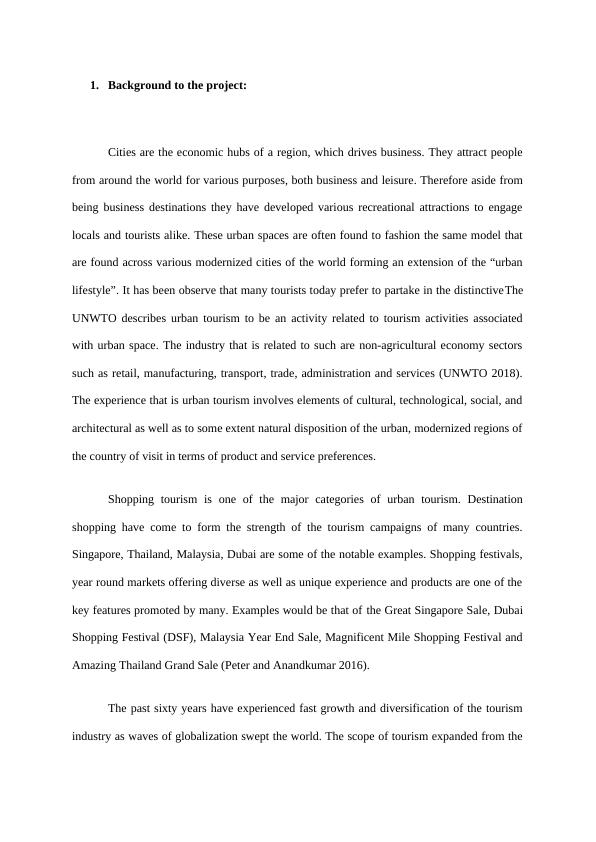
traditional regions in Europe and the Americas to the Middle East and Asia and the
developing urban spaces in these places created scopes where tourist haunts aligned with not
only traditional and natural attractions of the region but also the recreational attractions of
urban spaces and culture such as the restaurant culture in Australia and shopping cultures in
countries like Singapore, HongKong and Dubai among others. The UNWTO in their global
tourism report from 2014 said that the worldwide tourist arrivals is anticipated to increase at a
rate of 3.3% per annum between the years 2010 and 2030 on an average, amounting to about
1.8 billion arrival in 2030. Simultaneously, in 2015, 54 percent of the world population were
found reside in urban area which would increase to 60 percent by 2030 (UNWTO 2014).
Hence it is anticipated that urban tourism would be following suit in terms of growth as well.
This provides a novel opportunity for countries to strengthen the economy by focusing on
developing their urban tourism market, especially the shopping tourism market. This can be
attributed to the fact that shopping tourism is intrinsically related to the retail and
manufacturing industry, which provides immense scope of employment for the locals. It not
only contributes to the economy but also gives patronage to local handicrafts and
craftsmanship hence contributing to heritage development. This is interesting since heritage
development can then be in turn used to further develop the tourism industry. Therefore
shopping tourism is a phenomenon that is fast emerging and which has the potential to
diversify economy further in the future.
According to a study by Kumar and Upadhyay(2017), there are about9 million
tourists that visit Dubaievery year. The study had identified how night shopping is a rising
trend in the country, especially during the month of Ramadan. Another reason that was
identified is that the tourists sought to avoid crowds during the day. Among the major factors
identified, the study lists that safe environment, transportation facilities and amenities as
being significant. A study by Mehta, Jain and Jawale (2014), made useof discriminant
developing urban spaces in these places created scopes where tourist haunts aligned with not
only traditional and natural attractions of the region but also the recreational attractions of
urban spaces and culture such as the restaurant culture in Australia and shopping cultures in
countries like Singapore, HongKong and Dubai among others. The UNWTO in their global
tourism report from 2014 said that the worldwide tourist arrivals is anticipated to increase at a
rate of 3.3% per annum between the years 2010 and 2030 on an average, amounting to about
1.8 billion arrival in 2030. Simultaneously, in 2015, 54 percent of the world population were
found reside in urban area which would increase to 60 percent by 2030 (UNWTO 2014).
Hence it is anticipated that urban tourism would be following suit in terms of growth as well.
This provides a novel opportunity for countries to strengthen the economy by focusing on
developing their urban tourism market, especially the shopping tourism market. This can be
attributed to the fact that shopping tourism is intrinsically related to the retail and
manufacturing industry, which provides immense scope of employment for the locals. It not
only contributes to the economy but also gives patronage to local handicrafts and
craftsmanship hence contributing to heritage development. This is interesting since heritage
development can then be in turn used to further develop the tourism industry. Therefore
shopping tourism is a phenomenon that is fast emerging and which has the potential to
diversify economy further in the future.
According to a study by Kumar and Upadhyay(2017), there are about9 million
tourists that visit Dubaievery year. The study had identified how night shopping is a rising
trend in the country, especially during the month of Ramadan. Another reason that was
identified is that the tourists sought to avoid crowds during the day. Among the major factors
identified, the study lists that safe environment, transportation facilities and amenities as
being significant. A study by Mehta, Jain and Jawale (2014), made useof discriminant
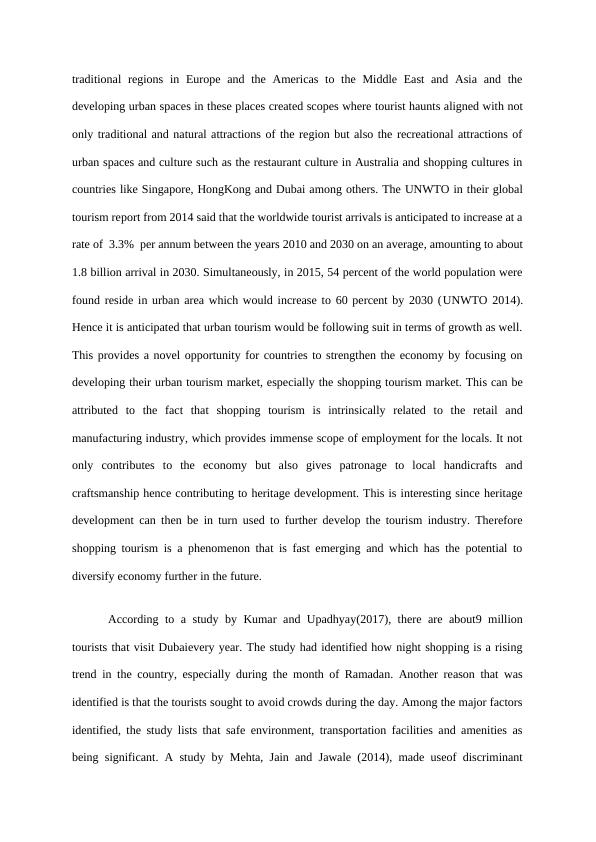
analysis to study tourist trends in Dubai. As per the results of the study, retail, specifically
those based on high end malls characterized by “brand value” and “variety” are what for the
major part influenced tourist interest in Dubai as opposed to factors such as “price” and that
tourist attitude towards Dubai is a changing premise based on the changing brand presence in
the region.
This paper draws attention to the bustling shopping tourism offered by Dubai. Dubai
is known to be the shopping capital of the Middle East offering state of the art shopping
complexes and markets drawing retailers and tourists from all across the world. The aim is to
explore and identify the key factors that is behind the thriving shopping tourism business of
Dubai, such as what attracts a tourist to prefer or choose Dubai as a shopping destination.
This paper makes use of primary data collected using survey questionnaire to form a
descriptive statistical study of the trends and preference of tourists with regard to their views
about shopping culture in Dubai and about the impact of existing policies and infrastructure
on the same.
2.Concepts and relevant theories:
Szytniewski, Spieringsand van der Velde (2015) had conducted an investigation of
how socio-cultural proximity plays a role on tourism experience in the context of the tourist
movement along the Dutch-German border area. The authors had used their paper to explore
a multi-dimensional approach towards the issue, in light of tourists who reside in
geographically close regions but are in fact culturally different. The study establishes that
such proximities go on to positively impact the shopping tourism experience with greater
comfort reported by the cross-border tourists. However the authors also point out that their
results are subject to the fact that the premise of their study is based on stable and open
borders and that the relationship needs to be explored in a larger and more diverse context.
those based on high end malls characterized by “brand value” and “variety” are what for the
major part influenced tourist interest in Dubai as opposed to factors such as “price” and that
tourist attitude towards Dubai is a changing premise based on the changing brand presence in
the region.
This paper draws attention to the bustling shopping tourism offered by Dubai. Dubai
is known to be the shopping capital of the Middle East offering state of the art shopping
complexes and markets drawing retailers and tourists from all across the world. The aim is to
explore and identify the key factors that is behind the thriving shopping tourism business of
Dubai, such as what attracts a tourist to prefer or choose Dubai as a shopping destination.
This paper makes use of primary data collected using survey questionnaire to form a
descriptive statistical study of the trends and preference of tourists with regard to their views
about shopping culture in Dubai and about the impact of existing policies and infrastructure
on the same.
2.Concepts and relevant theories:
Szytniewski, Spieringsand van der Velde (2015) had conducted an investigation of
how socio-cultural proximity plays a role on tourism experience in the context of the tourist
movement along the Dutch-German border area. The authors had used their paper to explore
a multi-dimensional approach towards the issue, in light of tourists who reside in
geographically close regions but are in fact culturally different. The study establishes that
such proximities go on to positively impact the shopping tourism experience with greater
comfort reported by the cross-border tourists. However the authors also point out that their
results are subject to the fact that the premise of their study is based on stable and open
borders and that the relationship needs to be explored in a larger and more diverse context.
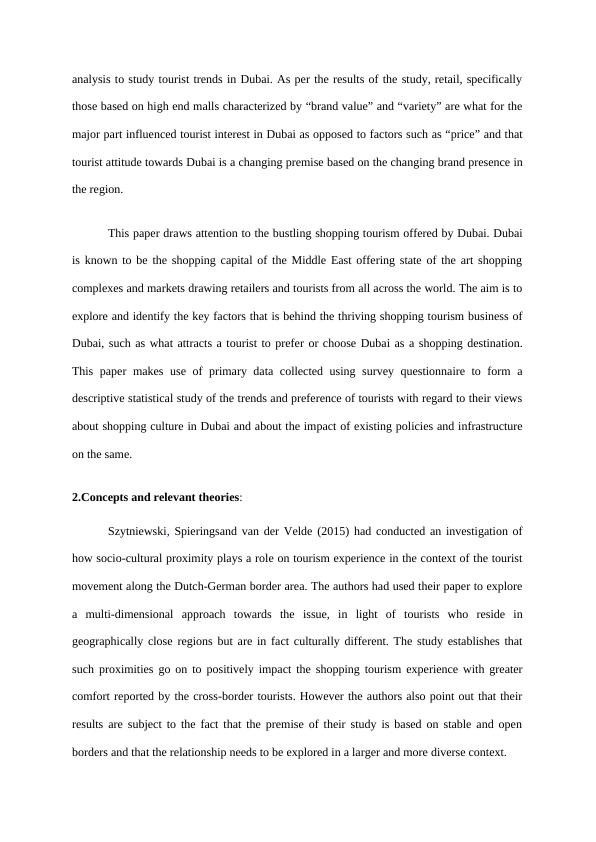
There are papers such as Zaidan (2015) which establish that shopping tourism is not
only related to retail but also it is a subsidiary experience of tourists seeking not only the
shopping experience but the overall experience of exciting materialistic, luxury experience
integrating shopping, food and entertainment. Hence the experience demands for more than
shopping attractions but also establishment of unique and distinctive experiences which
deliver certain ambience. The focus is therefore shifted from performance of individual
retailers to shopping complexes which offer a wide range of services. The paper identifies
luxury shopping experience as a viable avenue to be relevant in the context of Dubai. It
reflects that people opting for Dubai seem to seek out the experience of lavishness that Dubai
can offer and a more cosmopolitan approach to shopping. Establishments such as the Gold
Souk which dazzle customers and which many identify as the reason that Dubai is called
“City of Gold” offer experiences such as desert safaris and free Dhow cruises. Zaidan (2015)
identified that such experiences are what successfully draws and satisfies tourist attention.
The current tourism is Dubai is heavily influenced by global urban culture where people from
various cultures come together to showcase and celebrate heritages from across the world,
making for a truly global and cosmopolitan experience. The Global village in Dubai drew 5
million tourists showcasing, 12000 exhibitions from sixty five countries in 2014 alone
(GlobalVillage, 2014). It is therefore evident that infrastructure plays a big role in the success
of a shopping tourism project which facilitates such a global setting to be established.
Zhogi and Khosravi (2014) in their study of the scope of shopping tourism in Baneh
had identified a number of factors which had posed as a challenge to promotion of shopping
tourism in the city. Security and border policies, trade and reluctance of indigenous people to
accept cultural exposure of the tourists and lack of skilled force to guide the tourists. The
authors emphasized the necessity of trade policies which are conducive to global trade is
essential. Setting up of trade zones and the supportive infrastructure and man power are some
only related to retail but also it is a subsidiary experience of tourists seeking not only the
shopping experience but the overall experience of exciting materialistic, luxury experience
integrating shopping, food and entertainment. Hence the experience demands for more than
shopping attractions but also establishment of unique and distinctive experiences which
deliver certain ambience. The focus is therefore shifted from performance of individual
retailers to shopping complexes which offer a wide range of services. The paper identifies
luxury shopping experience as a viable avenue to be relevant in the context of Dubai. It
reflects that people opting for Dubai seem to seek out the experience of lavishness that Dubai
can offer and a more cosmopolitan approach to shopping. Establishments such as the Gold
Souk which dazzle customers and which many identify as the reason that Dubai is called
“City of Gold” offer experiences such as desert safaris and free Dhow cruises. Zaidan (2015)
identified that such experiences are what successfully draws and satisfies tourist attention.
The current tourism is Dubai is heavily influenced by global urban culture where people from
various cultures come together to showcase and celebrate heritages from across the world,
making for a truly global and cosmopolitan experience. The Global village in Dubai drew 5
million tourists showcasing, 12000 exhibitions from sixty five countries in 2014 alone
(GlobalVillage, 2014). It is therefore evident that infrastructure plays a big role in the success
of a shopping tourism project which facilitates such a global setting to be established.
Zhogi and Khosravi (2014) in their study of the scope of shopping tourism in Baneh
had identified a number of factors which had posed as a challenge to promotion of shopping
tourism in the city. Security and border policies, trade and reluctance of indigenous people to
accept cultural exposure of the tourists and lack of skilled force to guide the tourists. The
authors emphasized the necessity of trade policies which are conducive to global trade is
essential. Setting up of trade zones and the supportive infrastructure and man power are some

of the challenges that Baneh had faced. Comparing this to another study by Zaidan (2015) on
Dubai, it is clear that these are valid points. Dubai is seen to be one of the iconic shopping
destinations of the region and comparing the operations in Dubai, the importance of local
attitude and infrastructure is apparent.
A particular attraction of interest in the context of shopping tourism are shopping
festivals which are today being utilized as products for tourism. Peter and Anandkumar
(2014) present a study of how shopping festivals in Dubai have been successful in drawing
tourist interest to the city impacting retail and tourism. They studies the responses of
international tourists to the Dubai Shopping Festival(DSF) in 2013 with the intent of guiding
stakeholders to design their products and improve shopping setting. The authors identified
window displays or product presentation, variety, linguistic competency in various
international languages and behavior of onsite staff as important aspects driving customer
experience in such events. The study in contradiction to some of the findings of Zaidan
(2015) says that tourists to such events are unlikely to be bothered by overcrowding as they
expect it and neither do architecture of the venue. Instead it is the promotional schemes and
sales policy that work to draw more tourists. In a similar work by the authors in 2016, the
authors compared the nationalities of the tourists to such festivals in Dubai and present a
study on the comparison of their preferences.
Peter and Anandkumar (2016) reveal that cultural difference indeed have a
significant impact on the tourist expectations and experiences among those travelling to
shopping festivals in Dubai. They identified 23 different nationalities who differ in terms of
motivations and hence assert that these groups ought to be viewed upon as heterogeneous
groups when planning promotional campaigns. It was found that while the novelty of
“Shopping festivals” was more effective as a quality to attract those in East Asian countries
such as Japan, “Place safety” is more effective towards Europeans. Hence an understanding
Dubai, it is clear that these are valid points. Dubai is seen to be one of the iconic shopping
destinations of the region and comparing the operations in Dubai, the importance of local
attitude and infrastructure is apparent.
A particular attraction of interest in the context of shopping tourism are shopping
festivals which are today being utilized as products for tourism. Peter and Anandkumar
(2014) present a study of how shopping festivals in Dubai have been successful in drawing
tourist interest to the city impacting retail and tourism. They studies the responses of
international tourists to the Dubai Shopping Festival(DSF) in 2013 with the intent of guiding
stakeholders to design their products and improve shopping setting. The authors identified
window displays or product presentation, variety, linguistic competency in various
international languages and behavior of onsite staff as important aspects driving customer
experience in such events. The study in contradiction to some of the findings of Zaidan
(2015) says that tourists to such events are unlikely to be bothered by overcrowding as they
expect it and neither do architecture of the venue. Instead it is the promotional schemes and
sales policy that work to draw more tourists. In a similar work by the authors in 2016, the
authors compared the nationalities of the tourists to such festivals in Dubai and present a
study on the comparison of their preferences.
Peter and Anandkumar (2016) reveal that cultural difference indeed have a
significant impact on the tourist expectations and experiences among those travelling to
shopping festivals in Dubai. They identified 23 different nationalities who differ in terms of
motivations and hence assert that these groups ought to be viewed upon as heterogeneous
groups when planning promotional campaigns. It was found that while the novelty of
“Shopping festivals” was more effective as a quality to attract those in East Asian countries
such as Japan, “Place safety” is more effective towards Europeans. Hence an understanding
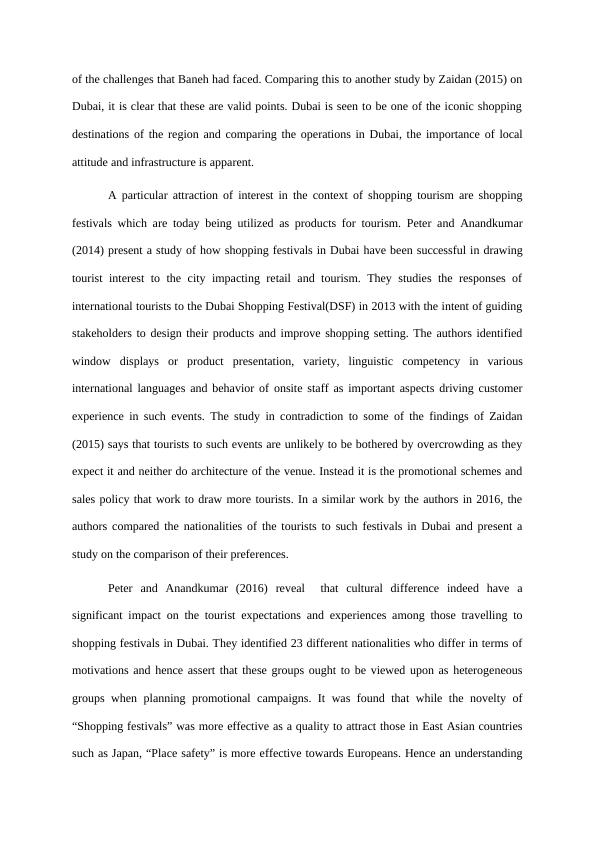
of the core motivations of different groups could be useful from a marketing and promotional
standpoint.
3. Proposed research methodology and analysis:
3.1. Research Objectives:
The primary objective of this paper is to explore the emerging trend of shopping
tourism in Dubai. It will investigate the various motivations of the tourists in Dubai, engaging
in urban tourism, specifically shopping tourism. The paper will then aim to identify tourist
profiles and identify key points that draw them to Dubai given the existing trends. The study
in turn would try to identify scopes of improvement in the current setup of Dubai in light of
the identified trends.
3.2. Research Questions:
What kind of tourists visit Dubai?
What are the attributes that tourists to Dubai expect from the area?
What attracts tourists to Dubai?
What can be done to improve the shopping tourism scene in Dubai?
3.3. Methodology:
The study conducts a survey of tourists travelling to Dubai. The study collects data
using an online survey questionnaire, collecting data on demographic information of the
tourists, their age, gender, nationality, income, education and occupation. Additionally the
survey collected data regarding the general perception of the tourists with regard to Dubai as
a shopping destination and urban tourism attraction. Following Krosnick(2018) and the
various relevant previous literatures, the data also records in the form of a five point Likert-
standpoint.
3. Proposed research methodology and analysis:
3.1. Research Objectives:
The primary objective of this paper is to explore the emerging trend of shopping
tourism in Dubai. It will investigate the various motivations of the tourists in Dubai, engaging
in urban tourism, specifically shopping tourism. The paper will then aim to identify tourist
profiles and identify key points that draw them to Dubai given the existing trends. The study
in turn would try to identify scopes of improvement in the current setup of Dubai in light of
the identified trends.
3.2. Research Questions:
What kind of tourists visit Dubai?
What are the attributes that tourists to Dubai expect from the area?
What attracts tourists to Dubai?
What can be done to improve the shopping tourism scene in Dubai?
3.3. Methodology:
The study conducts a survey of tourists travelling to Dubai. The study collects data
using an online survey questionnaire, collecting data on demographic information of the
tourists, their age, gender, nationality, income, education and occupation. Additionally the
survey collected data regarding the general perception of the tourists with regard to Dubai as
a shopping destination and urban tourism attraction. Following Krosnick(2018) and the
various relevant previous literatures, the data also records in the form of a five point Likert-
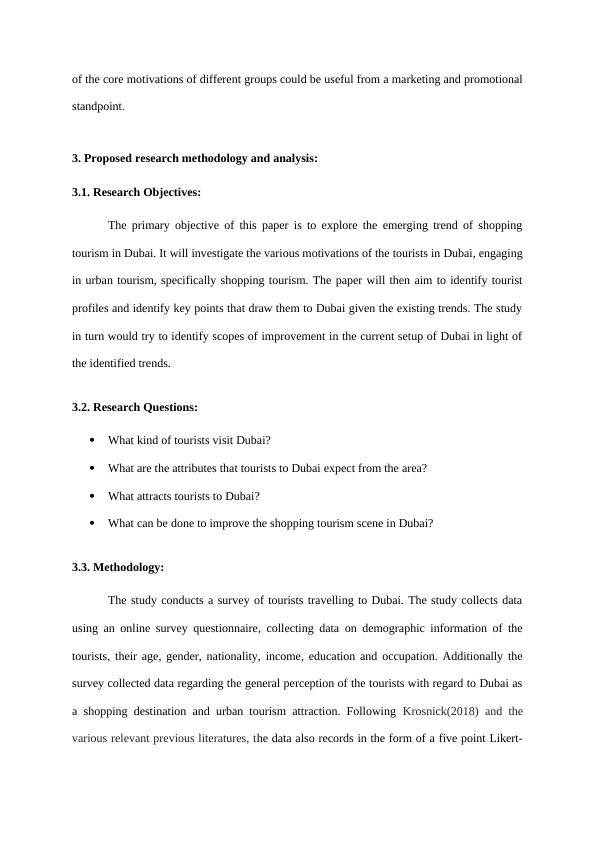
End of preview
Want to access all the pages? Upload your documents or become a member.
Related Documents
Attractiveness of Universal Studio Singapore (USS) among International Visitorslg...
|25
|5616
|245
